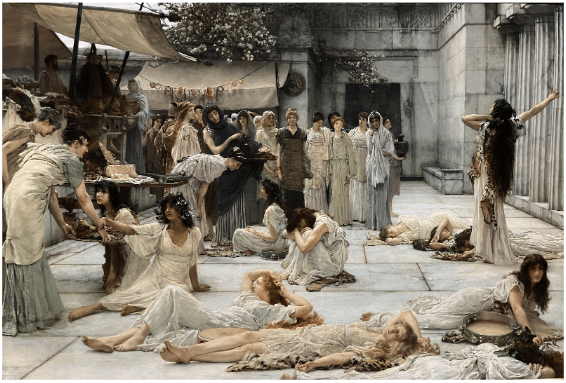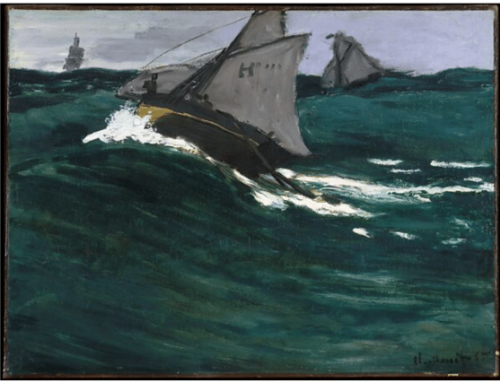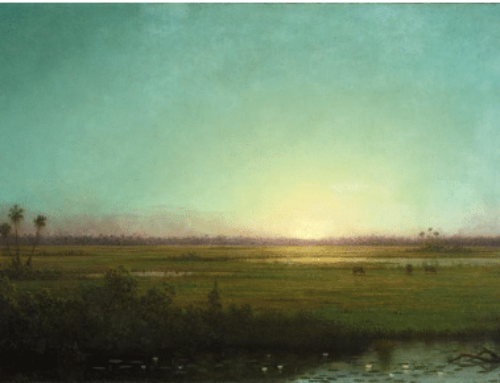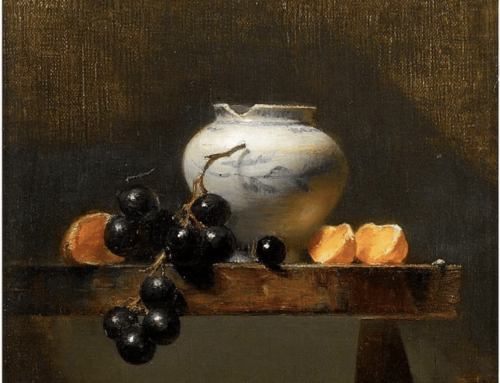“Art is Imagination and those who love Art love it because in looking at a picture it awakens their imagination and sets them thinking.” – Lawrence Alma-Tadema
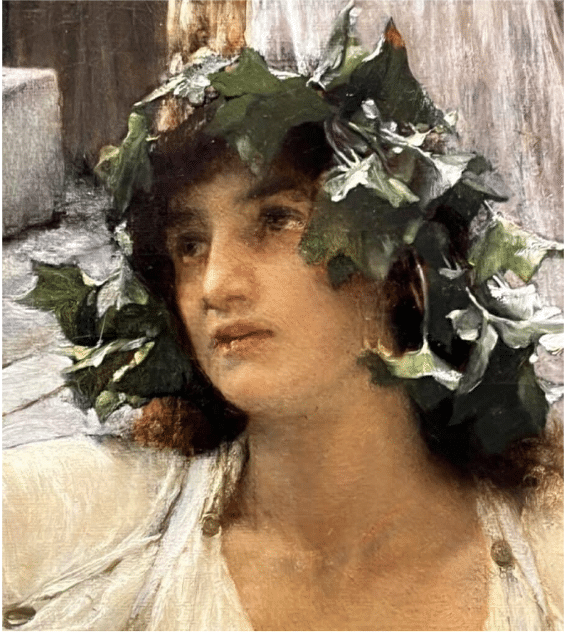
Detail from The Womon of Amphissa, Lawrence Alma-Tadema. (1887). Approx. 40 x 30 inches.
In the painting titled The Women of Ampshissa, followers of Dionysus, the god of wine (Bacchus to the Romans), awaken from late-night ritual-dancing in the public marketplace of Amphissa, Greece, where they’ve wandered from their home in Phocis. Unfortunately, the two cities, Phocis and Amphissa, happen to be at war.
So the Amphissian women gather and form a circle around the sleeping strangers, the primary purpose of which is to keep the Phocian women, who seem to be younger, safe from the garrisons of soldiers stationed in the center of town. The artist paints the expressions of the Amphissians on a spectrum of bravery, defiance, sympathy and resolve.
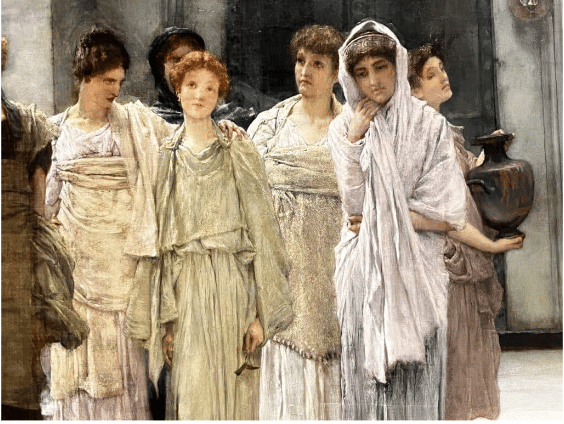
Detail from The Amphissian Women by Lawrence Alma-Tadema. (1887).
In the center of the circle, other Amphissan women graciously offer the bacchantes nourishment and protection. The painting references a real-life historical event recorded by the Roman historian Plutarch, staged as a lesson in charity for the painting’s Victorian audience.
The artist, Sir Lawrence Alma-Tadema, was one of the most popular painters of the Victorian era. His paintings with their lovingly rendered details delighted the public; critics, however, often noted a lack of drama in his work. Current art historians say the drama was there, it was just subtle – and that’s what we’re looking at today.
Though you have to think about it to realize it, Alma-Tadema casts us, the viewers, in the role of an additional group in the circle of women in the Amphissian marketplace. We’re standing in the other half of that circle and facing in toward the sleeping bacchantes.
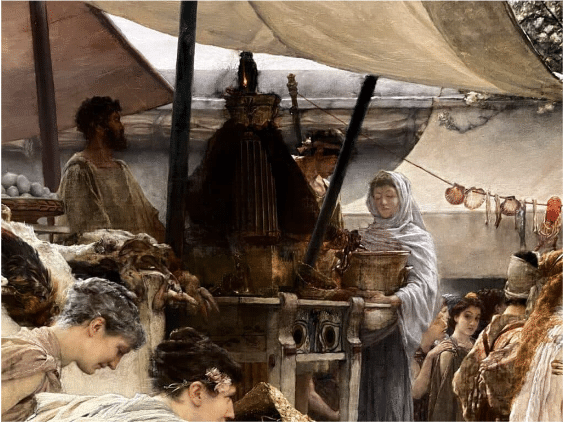
Detail from The Amphissian Women by Lawrence Alma-Tadema. (1887).
The Amphissian Women is among Alma-Tadema’s largest and most complex canvases. It’s a tour-de-force not only of elaborate and powerful composition(s) but of photorealistic mastery: a lush montage of marvelous surfaces (particularly his marble and his textiles), varied textures, interior/ exterior spaces, beautiful faces, and the stately figures draped in historical costume dress.
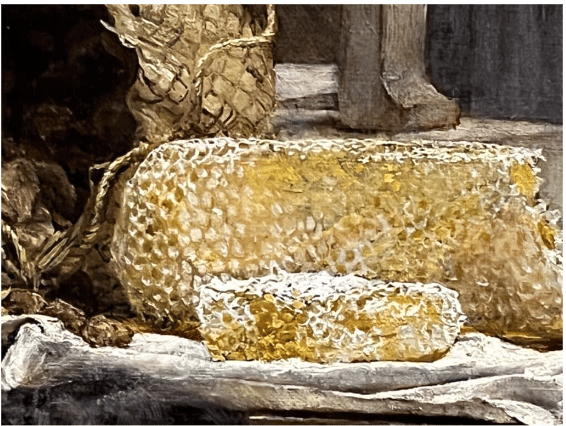
Detail from The Amphissian Women by Lawrence Alma-Tadema. (1887).
Looking at the details, you can see any number of paintings-within-paintings. There are several beautifully composed still lifes in miniature and lots to see in terms of body language and the interactions between the figures.
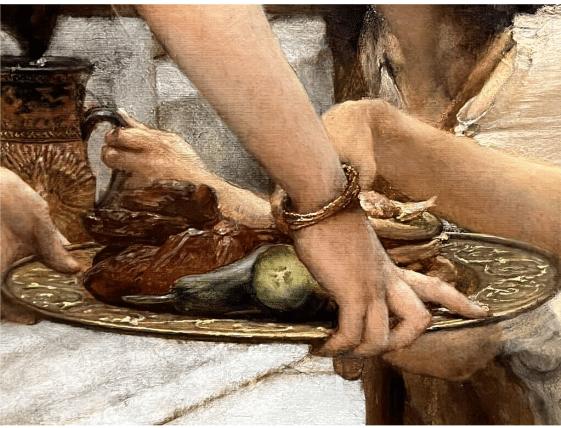
Detail from The Amphissian Women by Lawrence Alma-Tadema. (1887).
This painting is perhaps the only existing representation of this ancient story about the priestesses of Dionysus. It’s so richly imagined, so dense, meticulous and realistically rendered that it’s like being taken back to a moment from classical antiquity frozen in time. To view its details is to enjoy a veritable feast for artistic eyes.
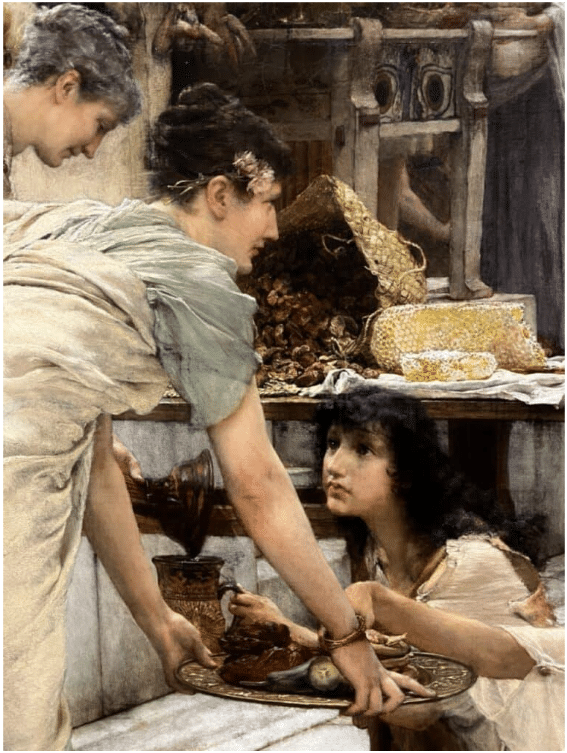
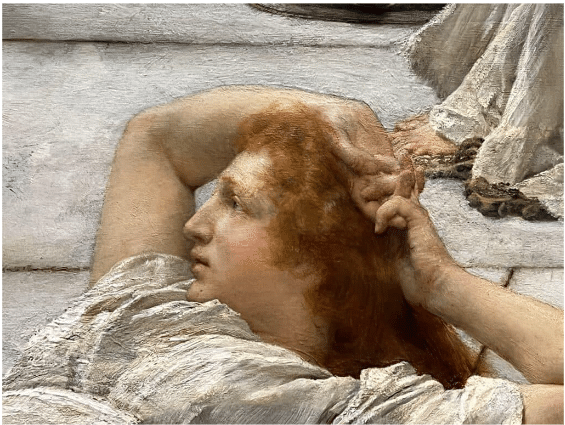
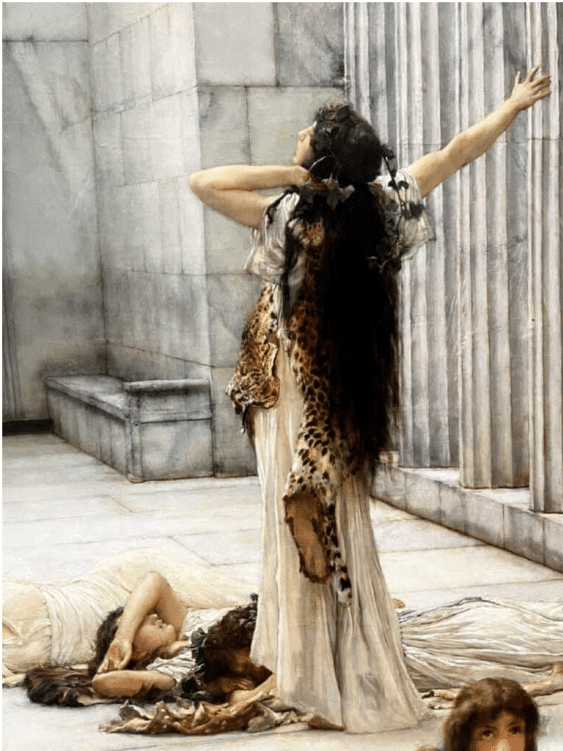
The morning after, details from The Amphissian Women by Lawrence Alma-Tadema.
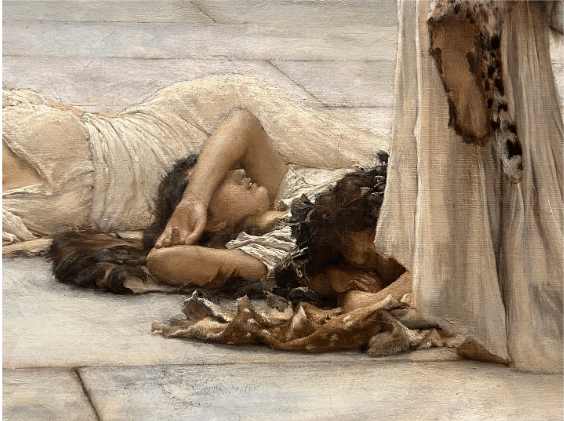
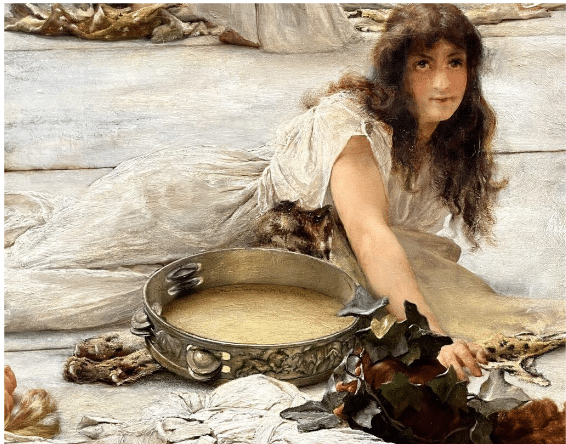
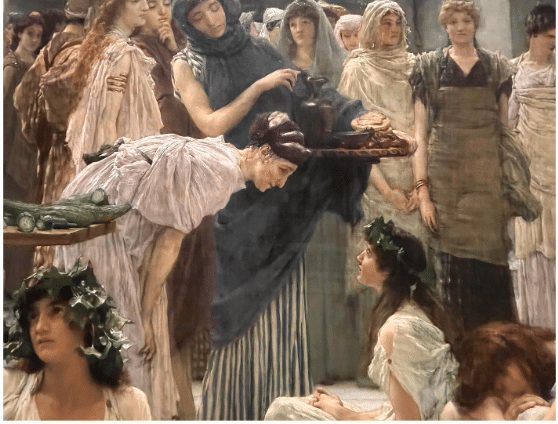
By the way, if we zoom back out again, it’s worth noting how simple and solid the composition of this painting is. It’s a centered, symmetrical oval with a simple crisscross armature. A very judicious, stable design for such a populated and detailed canvas.
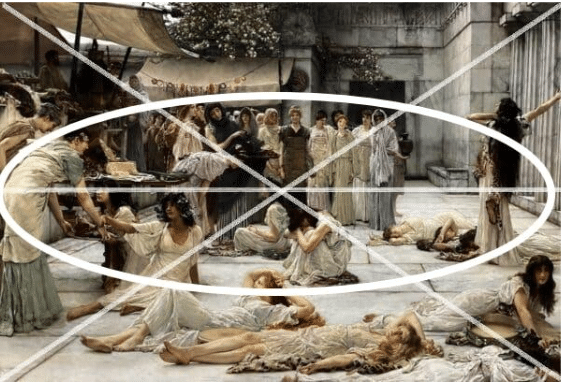 ‘
‘
Alma-Tadema’s painting has a message for us, just as it did for its Victorian contemporaries. It’s there in the resolute faces of the standing protectors, and it’s there in the freely offered nourishment that the Amphissian women share with the “enemy.” These zonked-out, wayward bacchantes could be seen as our equivalent of a bunch of dirty (look at their bare feet), homeless “foreigners,” hungover no less, members of a filthy, irresponsible cult showing up and passing out in front of the Starbucks and Targets and what’s left of the independent mom-and-pops of our main-street businesses (our equivalent of the public marketplace). The message is compassion.
To us, some 1500 years after the incident, it’s a challenge to tell the two “sides” of the two warring cities apart. And that’s the point. The real challenge is put our differences aside. Whatever our circumstances, we’re all human beings, and the only way we survive as a decent civilization is by caring for each other.
The Amphissian Women won the Gold Medal of Honor at the Exhibition Universelle in Paris in 1889. You can view it in person in the permanent collection of the Clark Museum in Massachusetts.
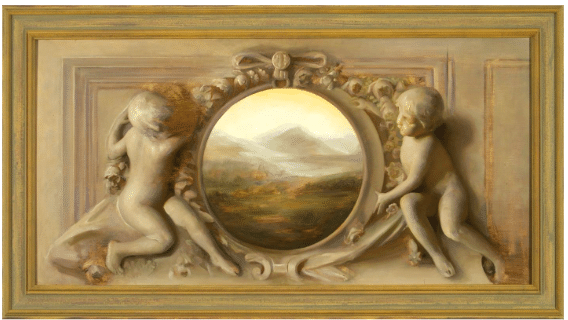
Oil painting by Juliette Aristides (that’s not a frame – it’s the painting!)
If classical realism fascinates you as it does so many artists, why not consider the instructional video by Juliette Aristides, Secrets of Classical Realism.
Juliette Aristides is a Seattle-based painter who seeks to understand and convey the human spirit through art. She teaches workshops both nationally and internationally, and founded the Aristides Atelier online through Terracotta.
Author of Classical Drawing Atelier: A Contemporary Guide to Traditional Studio Practice, Classical Painting Atelier: A Contemporary Guide to Traditional Studio Practice, Lessons in Classical Drawing and Lessons in Classical Painting, published by Watson-Guptill, NY. Aristides is the founder of the Classical Atelier at the Gage Academy of Fine Art in Seattle, WA and instructed there for over two decades. Readers may know her from her teaching video.
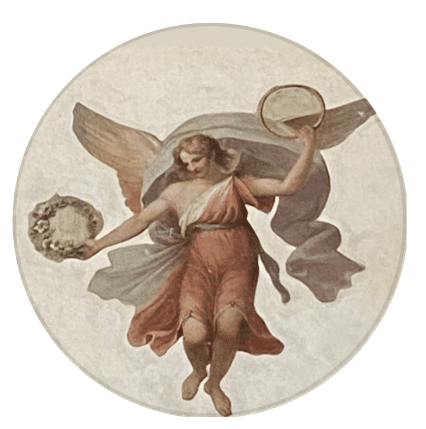
Tondo in Santa Croche in Florence, Italy, photographed by contemporary classical painter Juliette Aristides.
“The best way to learn about art is to make it,” she says. “Discover the secrets of great figure drawing as you sketch along with past and present masters… It’s your art, your tradition, your time. Take your voice and add it to the tradition as if the history of art has saved the best for now.”
Juliette is the founder and director of the Classical Atelier at the Seattle Academy of Fine Arts. She studied with realist master Jacob Collins and at the National Academy of Design and the Pennsylvania Academy of the Fine Arts. She provides artistic training to public school educators nationally. She frequently contributes to Artist & Illustrators and Artists Magazine. Her work has been featured in magazines such as Art Connoisseur, American Art Collector, American Artist and Gulf Connoisseur Magazine. She exhibits in one person and group shows nationally including a solo exhibition, “Observations” at the Reading Public Museum of Art in Reading, Pennsylvania (2014).
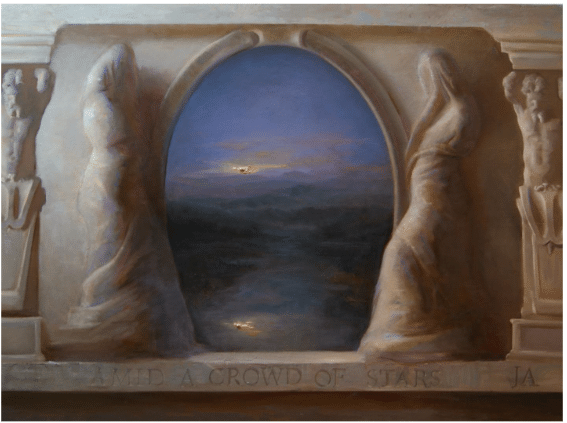
Oil painting by Juliette Aristides
Discover Treasures of European Art
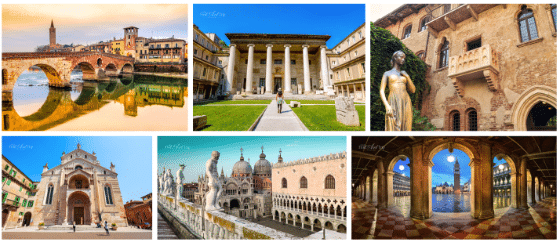
Each year, our sister publication Fine Art Connoisseur organizes a “behind the scenes” museum tour to one of the world’s great art cities. The group, limited in number of course, sees art from a new perspective with excursions to world-class museums, visits with artists, and iconic art experiences which take advantage of deep contacts in the art world. Hosted by Fine Art Connoisseur Publisher Eric Rhoads and Editor-in-Chief Peter Trippi, this year the destination is Italy’s Venice and Verona. Learn more here.

